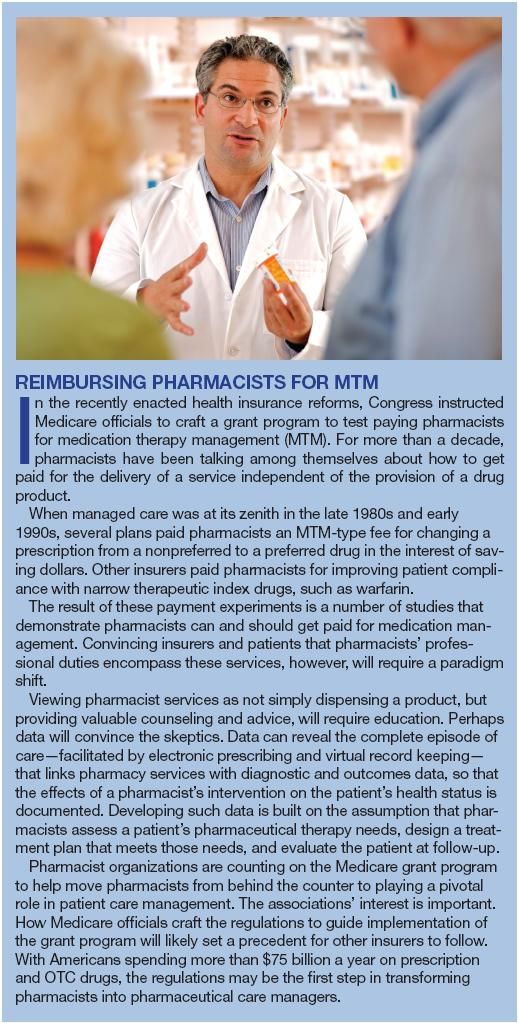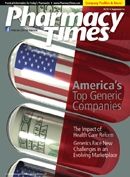Publication
Article
Generic Supplements
The Impact of Health Care Reform
Author(s):
The 2010 health care reforms affect the daily practices of pharmacists, especially as generic drugs play an even greater role in the cost containment of health care for millions of Americans.
Just over 100 days after Congress enacted major health care reform, known as the Patient Protection and Affordable Care Act, pharmacists are poised at the forefront of health service delivery changes. Some pharmacists are affected more than others. The impact of the health reforms varies according to the new requirements on the financing and coverage of prescription drugs that Congress placed on insurers, both private and public. Pharmacists will manage the changes depending on what type of insurance his or her pharmacy customers use.
Medicare beneficiaries, for instance, are seeing many changes in their coverage as the reforms repair the infamous “doughnut hole” and make enrollment changes. Those retirees not using Medicare Part D face increased drug costs because the health reform law reduced corporate subsidies for drug coverage, saving big corporations millions of dollars, but shifting the burden to many retired workers. Pharmacy customers newly eligible for expanded Medicaid benefits mandated by the health reforms will bring many additional pharmacy visits, but restricted Medicaid payments will continue for pharmacists.
While the vast majority of pharmacists’ customers are not affected by the health insurance reforms, they remain careful with their health dollars as the price of prescription drugs continues to escalate unconnected to general inflation. While Congress has provided laid-off workers with COBRA subsidies, access to food stamps, and Medicaid assistance, continued high unemployment continues to erode many Americans’ access to health care, including pharmaceuticals.
Private Insurers Required to Lower Barriers for Many
By requiring all Americans to have health insurance, Congress will add the customers needed to amortize the cost of the health care reforms across both private and public insurers. While estimates vary, pharmacists are likely to see many customers who previously had no insurance, due to preexisting conditions or other problems, and now are able to gain access to private insurance and prescription drug coverage.
The enacted reforms include elimination of lifetime caps and annual caps on benefits for individuals and group plans beginning in 2014. Insurers are prohibited from establishing eligibility rules based on genetic information, health status, medical conditions (including physical or mental illness), claims experience, utilization of services, medical history, disability, or evidence of insurability.
Medicaid Expands Access But Cost Pressures
Remain While the health care reforms shift many Medicaid costs to the federal government, pressures remain on states to reduce Medicaid spending, including prescription drug costs. State legislatures in 2010 are grappling with more than $127 billion in deficits— fueled in part by Medicaid costs, according to the National Association of State Budget Officers.
State officials are worried that if Congress does not approve an additional $24 billion to defray the cost of Medicaid, they will have to make deep cuts in benefits, coverage, and reimbursement to providers. By late June, Congress still had not appropriated the funds to enable states to shift some Medicaid expenses to the federal government, as permitted under the terms of the 2010 health care reforms.
Congress tapped the pharmaceutical industry to pay part of the cost of expanding Medicaid by requiring brand name and generic drug manufacturers to pay more in rebates to the states. For brand drugs, the rebate will increase to 23.1% from 15.1%; generic rebates have gone up to 13% from 11%.
Health care reform also moderated Medicaid drug costs by improving the Medicaid definition of the average manufacturer’s price (AMP) applicable to retail pharmacists. Now the federal upper limit will be no less than 175% of the average weighted AMP. Previously, Medicaid reimbursed for generics below acquisition cost. Starting in 2014, Medicaid will begin paying for smoking cessation drugs, barbiturates, and benzodiazepines.

Medicare Part D Benefits
Improved The 2010 health insurance reforms are best known to seniors for fixing the widely criticized Medicare Part D doughnut hole in which millions of American seniors previously found themselves after reaching the end of their drug benefits. By 2020, Medicare beneficiaries will pay just 25% of drug costs when they reach the coverage threshold—the same percentage they were responsible for before they reached that threshold.
The cost of closing the doughnut hole is being borne by generic and brand drug companies. Brand drug makers must provide a 50% discount on their drugs, beginning in 2011, and generic makers will be paid smaller subsidies over the next 10 years. By 2020, the doughnut hole will be completely closed through the manufacturers’ subsidies.
Here is how the subsidies work: Beginning in 2011, seniors will have to pay just 50% of the costs of brand name drugs when they are in the coverage gap. Their share of generic drug spending will also drop, but by a smaller amount, to 93%. The decline continues stepwise. For example, in 2015, Medicare beneficiaries will be responsible for 45% of the cost of brand name drugs in the doughnut hole and 65% of the cost of generic drugs, according to AARP. By 2020, seniors will owe 25 percent of the cost of both brand and generic drugs in the coverage gap—the same percentage for which they are responsible before they reached the doughnut hole.
The reforms also give seniors a onetime $250 rebate in 2010, which is being automatically mailed to them by Social Security. Also in 2010, beneficiaries can deduct 100% of the negotiated price—excluding dispensing fees—that they pay after coverage ends.
Pharmacists who counsel Medicare beneficiaries about Part D should be aware that the new law changes Medicare Part D enrollment procedures to permit seniors extra time in 2011 to enroll or switch their enrollment. Eliminated is a duplicative open enrollment period for Medicare Advantage plans. Beneficiaries next year will be allowed to withdraw from Medicare Advantage plans and return to traditional fee-for-service Medicare.
Those pharmacies whose total Medicare durable medical equipment billings are less than 5% of total prescription sales are exempt from new Medicare accreditation requirements in the health reform law. The exemption requires that the pharmacy also must not have any adverse fraud and abuse findings pending against it.
Medication therapy management (MTM)—long sought by pharmacists to enable them to be paid for their counseling services—was included in the final reform package. The new law includes a grant program to test and innovative methods to deliver MTM.
Also, Medicare prescription plans must provide seniors with a comprehensive review of their medications, either in person or through virtual consultation, and a written summary of the review as apart of their MTM programs. The American Pharmacists Association hailed the inclusion of MTM services as vital to reducing the toll of inappropriate medication use, including nonadherence.
More Generics Available and in Demand
The health care reforms were enacted during the so-called “patent cliff era” when several brand drugs have gone off patent and generics are frequently taking their place. The reforms came at the time the FDA was being asked to move faster to approve generic drug applications—including biologic drugs. With increasing inflation in brand drug costs, consumers continue to turn to less expensive generic alternatives, putting pressure on the federal government to expand access to cheaper generic drugs.
At the urging of the brand drug makers, Congress included in the health care reform package several provisions that will give longer market exclusivity to brand makers of biologics. Despite opposition from many consumer groups and the generic drug makers, the new FDA approval process for biogenerics now includes a 12-year market exclusivity provision for biologics innovators, a sharp contrast to the 7 years conventional drug makers enjoy under the Hatch- Waxman Act.
This provision has important implications for the 160 biologics currently on the market. Their use is becoming increasingly popular, as biologics will account for half of the new drugs approved in 2012 by the FDA. Also in 2012, 12 of the current top 20 biologic products driving US sales of $18 billion will drop off patent. In the next 5 years, patents are expiring on brand name drugs totaling more than $100 billion in annual sales, and the patent expiry is driving a surge of submissions to the FDA for generic drug applications.
Congressional passage of health insurance reforms is, of course, not the final chapter. Health associations and interest groups have shifted their focus to the Department of Health and Human Services and other federal agencies where regulations implementing the legislation are now being drafted. Generic drug makers are keeping a close eye on how the FDA will create an approval pathway for biosimilars. Pharmacists are monitoring how the Centers for Medicare & Medicaid Services develop the grant programs to test MTM.
Ms. Robinson is a freelance writer who lives in Bethesda, Maryland.







